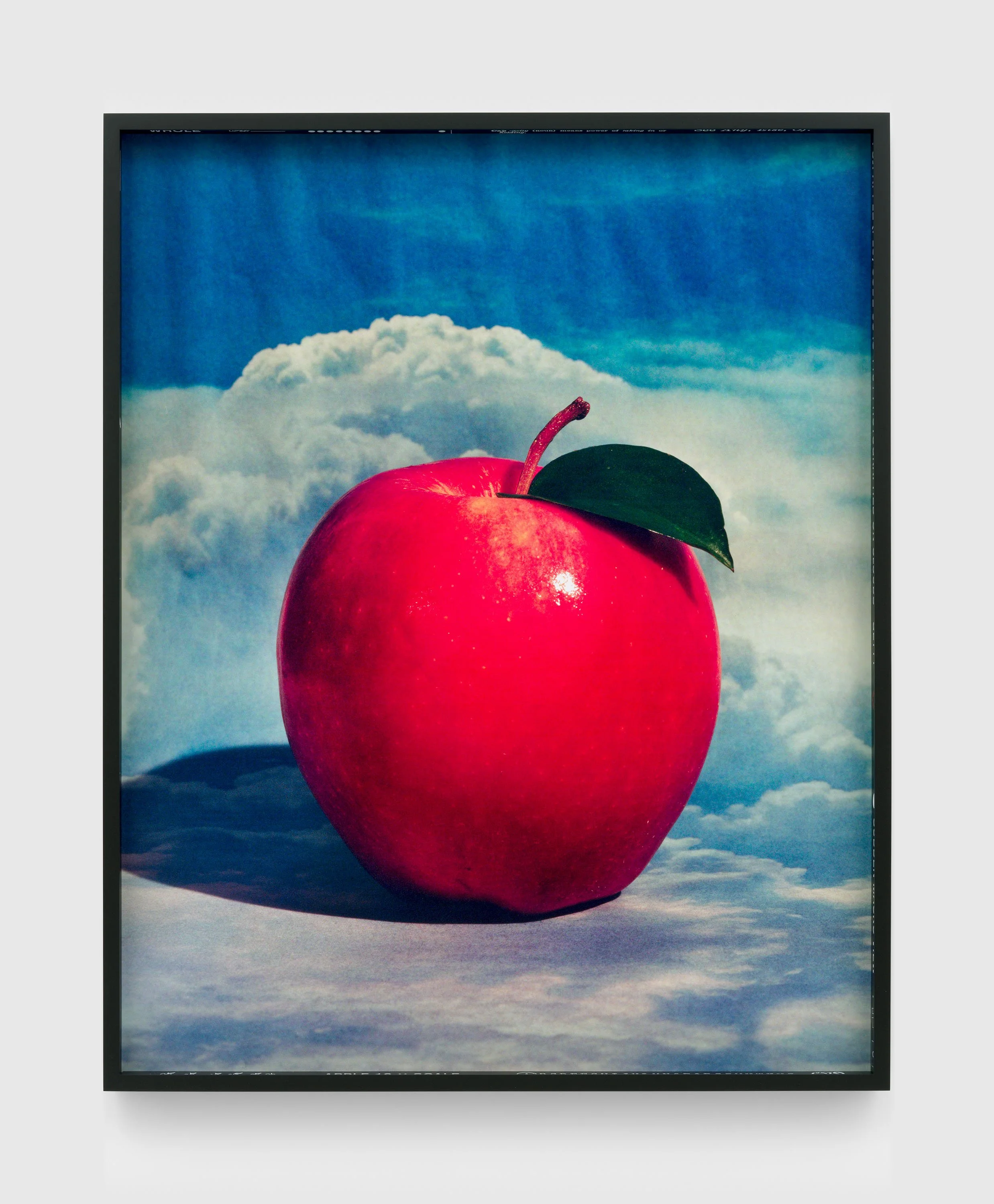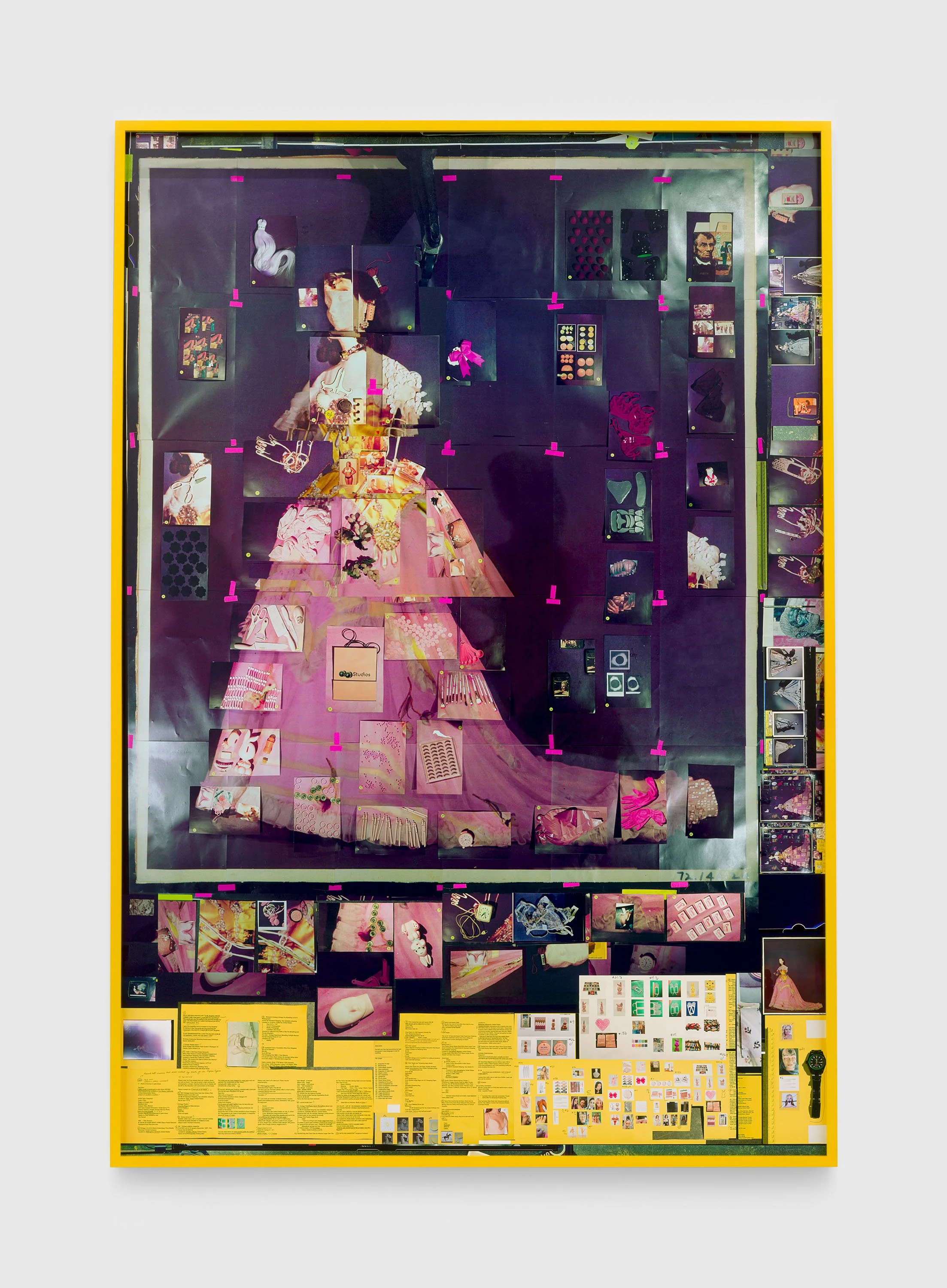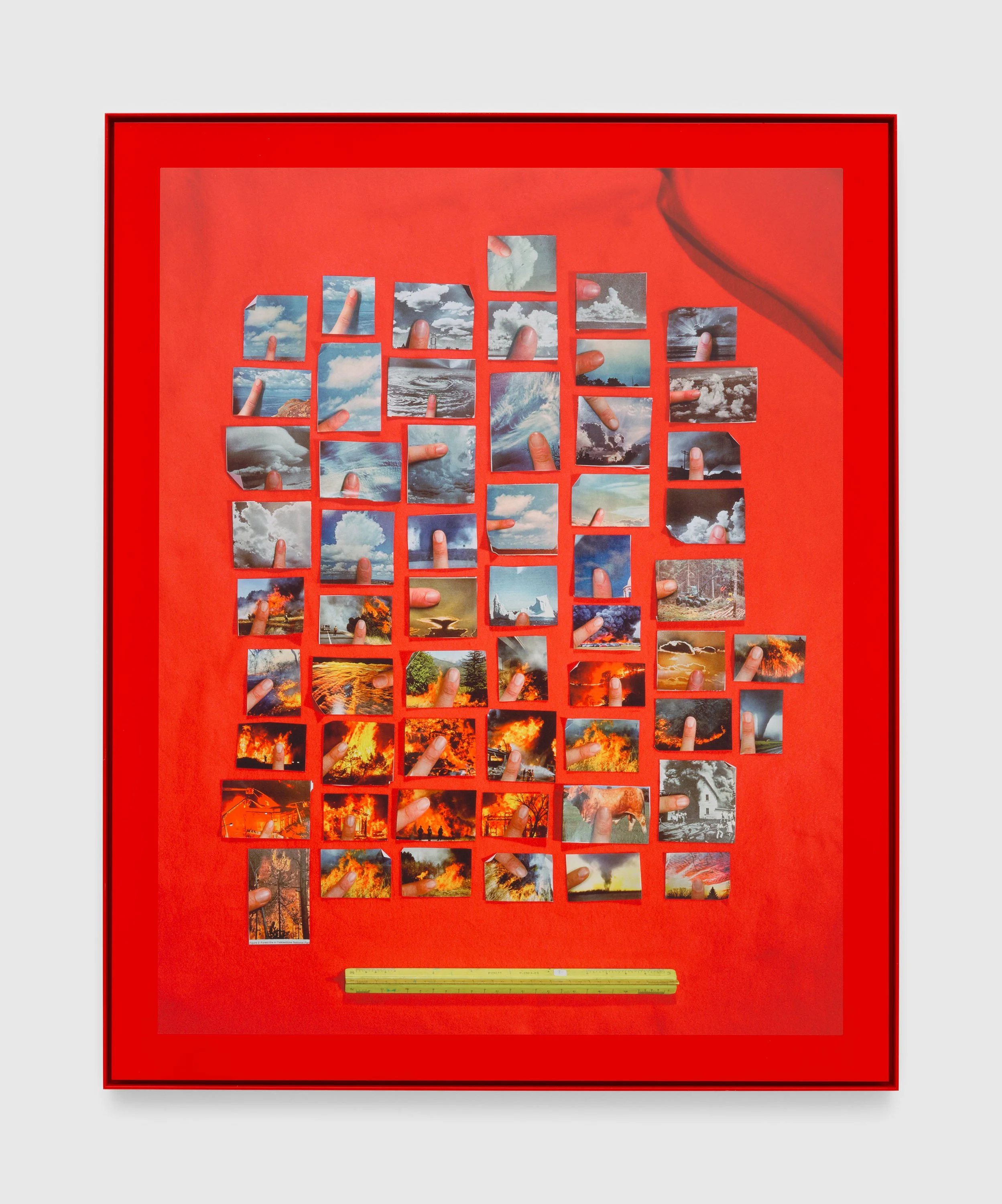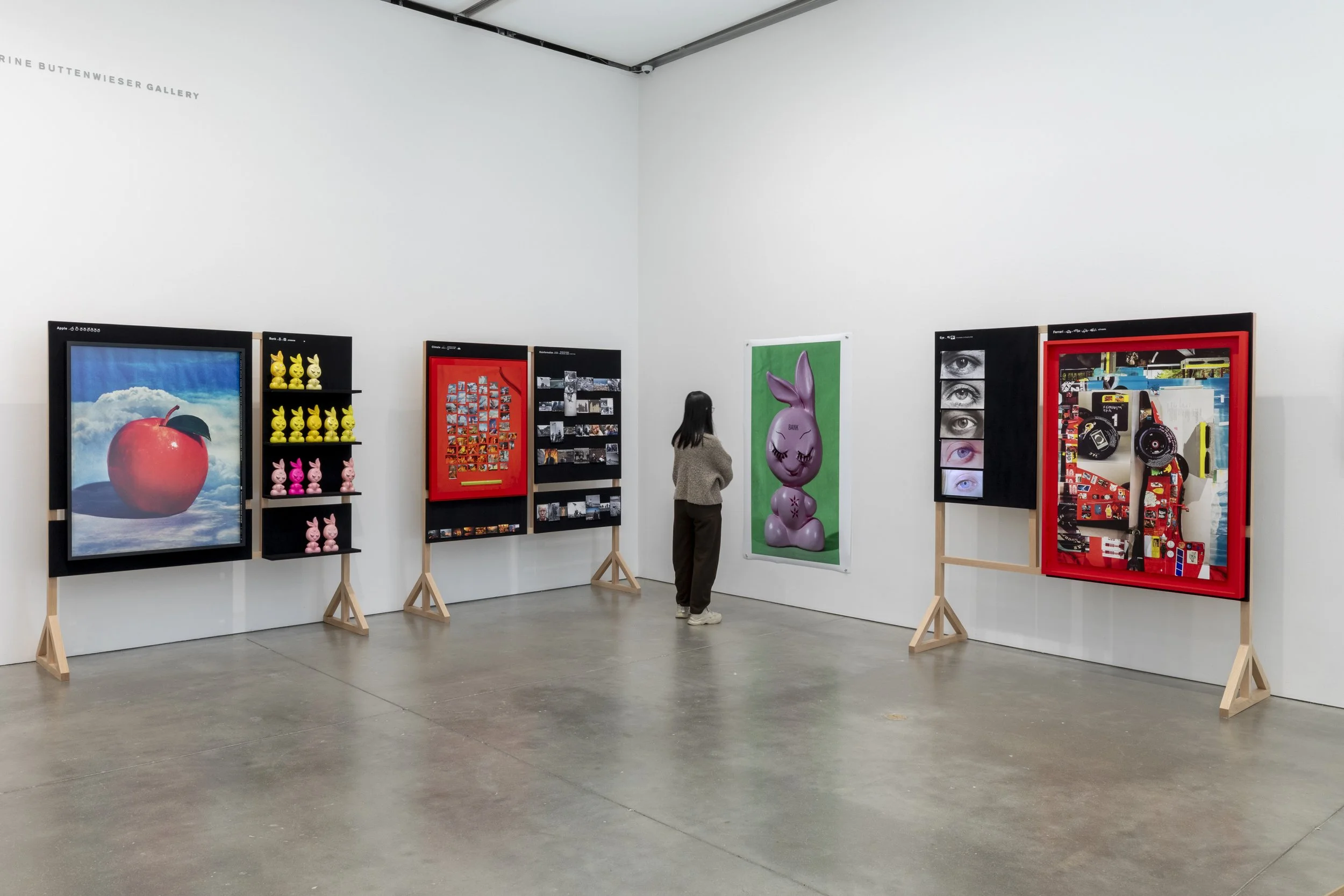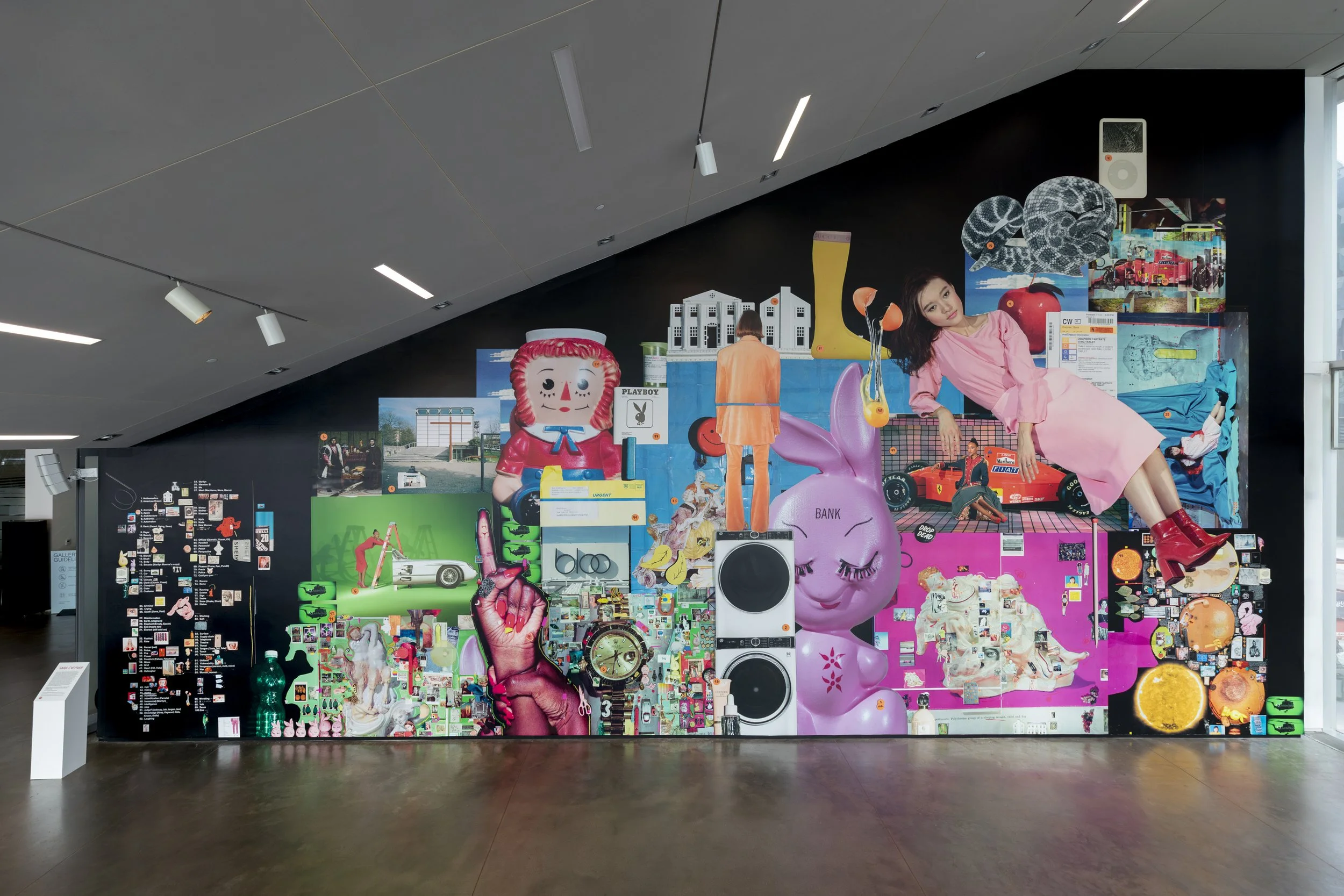By Megan Horn, March 10, 2025
Sarah Cwynar’s installations plunge like a Google search down the rabbit hole into complex linkages between historical authority, the allure of images, desire, and contemporary crises. The overlays of stock images and advertisements with personal images and recognizable artworks from the Western canon explode in colorful excess, and obscure the boundaries between public, private, and individual collecting habits. The work questions both official archives and the digital overflow of images that individuals consciously curate or unwittingly accumulate.
“Sara Cwynar: Alphabet” on view at the Institute of Contemporary Art in Boston until August 3, begins with a photomural for the foyer immediately greeting visitors with image-overload. In a Dada-esque photomontage of printed wallpaper, Cwynar jumbles gargantuan gestures, images of appliances, her own drug prescriptions and daily mail; models draped atop even more stacked images. Following this turtles-all-the-way-down descending the wall: smaller images, details, and text crowd the lower registers. To the left, an index of words numbered to correspond to the objects throughout the mural, rife with double meanings and perplexing associations. A woman depicted sideways in a light pink pinafore with neon stickers bearing the numbers for the words: fetus, uniform, war, vengeance, woman, wrestling, X, yolk, and zoo. In this sense, meanings pile up in the same way the images themselves are presented—as the bricolage of a flea market or even tagged objects compiled in museum storage.
This foyer installation might be thought of as an all-at-once collision of archival surplus. If that is the case, then the installation of “Alphabet” in the galleries is a studied product of that archive. Initially, the scheme might seem like a neat ordering of visual language that would belie the uncertainty Cwynar embraces throughout.
With each panel themed with a letter of the alphabet, Cwynar defines her word choice with both a definition and a pictogram, but the photographs refuse subservience. The first of the 26 black panels—reminiscent of school instructional displays-- that snake around the room is a seductively simple image of a gleaming red apple (the clichéd “A is for Apple”) against a sky backdrop that one might find at a J.C. Penny portrait studio. In the inner rim of the apple image frame, Cwynar includes definitions for the words “capable” and “capacity“ as the ability of taking in or holding knowledge and referencing Eve’s temptation in Eden. As though it were freshly picked, the apple presents a choice of whether to take the first bite and to face the irony and chaos of reality as told by images.
These black panels and assemblages refer to the collector and scholar, Aby Warburg’s (1866-1929) “Bilderatlas Mnemosyne”, a collection of over 1000 images from antiquity to the early 20th century that map the motifs of global visual culture. Taking Warburg as inspiration, “Alphabet” too seeks to map visual culture and orient ideas within images. However, Cwynar’s allusion to the literacy of the alphabet instead suggests a jumping off point. As its disclaimer, the alphabet itself is only a key for unpuzzling a cipher. Knowing the alphabet does not guarantee the ability to read or even understand any language at all.
The exhibition wastes no time progressing from “Apple” to the letter D as “Disinformation.” Here are pinned pictures demonstrating a pre-Photoshop editing and masking of figures, seeding distrust in the expectation of documentary truth, interspersed with Timothy O’Sullivan’s photographs of the aftermath of Civil War battles, that still show some evidence of the war’s carnage. Cwynar’s pairings emphasize how images flicker like mirages in the murky areas of nuance where language often stumbles.
Cwynar brings to the fore slippages in the categories assigned to images and the objects they represent. For the letter F, Cwynar presents a Ferrari that she appears to have cut, reassembled, annotated, and adhered images of other objects to. The car itself, both a luxury brand and an F1 racecar, is both a commodity and a billboard for brand sponsors. Cwynar seizes on the instability of these categories while including on the frame the very accession number that identifies the car as part of the Museum of Modern Art’s collection. At the top of the image, the sitters of Velazquez’s “Las Meninas” gaze outwardly – are they really to be grouped into the same category? Or are advertising, art, and commodity all entangled in the same pleasurable and desirous act of looking?
“Sarah Cwynar: Alphabet” marches on through museum inventories, ads, and her own sculpturally arranged collections of melamine dishware, oscillating between unpredictable tangents and speculation and meandering reflections that mirror Cwynar’s own frenzied scrawl within the works. Circling back from where it began, the exhibition concludes with the letter Y “Youth,” and Z “Zoo” as twin panels on the shared wooden armature. “Youth”, defined as vivid, bright, or as a pictogram of a clock, shows a range of young women modelling clothing in bright shades of red and lilac. Cwynar renders the colorful garments and the models, both exemplars of idealized beauty, as preserved specimens by pinning them to the panel as though they were a butterfly collection. In contrast to the frozen life of “Youth”, “Zoo” presents a taxonomy of legislative chaos. Cwynar defines “Zoo” only by a series of pictograms of various animals; photographs show where men and women, barely restrained by their suits and ties, tackle and seize each other in fits of rage in democratic forums.
The presentation of brawling legislators leaves room for dark humor—the configurations resemble the found images of women mud wrestling on the panel for W. The images in “Zoo” and others of fires and disastrous storms, mingle in the same defamiliarized context.
Just as one could endlessly cycle through these works attempting to identify every easter egg and understand every word Cwynar includes, translating and mulling over these questions could be endless. Trying to define a world expressed in images proves a Sisyphean task that is familiar to any citizen of the image saturated world. However, Cwynar’s work within the institutional authority of the museum, with its modification of Warburg’s experiment in meaning construction and with its appropriation of the fundamental basics of the ABCs, creates a lab within which the seduction of images and their evasion of the certainty of language can be plainly observed and experienced.
The allusion to contemporary urgency and unease pervade throughout. However, Cwyner’s process leaves the feeling that seeing our culture so clearly reflected back is not so unsettling as the thought that if we spiral too far into the lure of images, will we ever find a way out?
Megan Horn is a PhD student and teaching fellow in the History of Art & Architecture at Boston University studying photography and American art. She was a curatorial assistant at the Newport Art Museum.
SARA CWYNAR "Doll Index, 1985" 2024.
SARA CWYNAR "Encyclopedia Grid (Weather)" 2024.
SARA CWYNAR "Rococo Ferrari" 2024.
SARA CWYNAR ICA Boston Installation 2025.
SARAH CWYNAR Installation ICA 2025.

